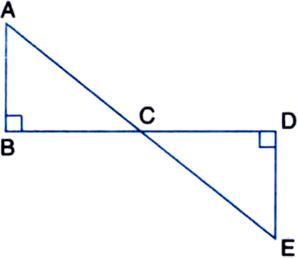 Multiple Choice Questions
Multiple Choice Questions
 Short Answer Type
Short Answer TypeShow that ΔABC, where A(–2, 0), B(2, 0), C(0, 2) and ΔPQR where P(–4, 0), Q(4, 0), R(0, 2) are similar triangles.
Prove that the area of an equilateral triangle described on one side of the square is equal to half the area of the equilateral triangle described on one of its diagonal.
Given: Square ABCD with diagonal BD △ BCE which is described on base BC △ BDF which is described on base BD both △ BCE and △ BDF equilateral
To prove: ![]()

Proof:
Both △ BCE and △ BDF equilateral
In △ BDF and △ BCE
![]()
Hence by SSS similarity
△ FBD ~ △ BCE
We know that in similar triangles,
Ratio of area of a triangle is equal to the ratio of the square of the corresponding sides

But DB = √2 BC as DB is the diagonal of square ABCD
Hence,

![]()
Hence Proved
 Long Answer Type
Long Answer TypeProve that, in a right triangle, the square on the hypotenuse is equal to the sum of the squares on the other two sides.
 Multiple Choice Questions
Multiple Choice QuestionsABCD is a rectangle whose three vertices are B (4, 0), C(4,3) and D(0, 3). The length of one of its diagonals is
5
4
3
25
